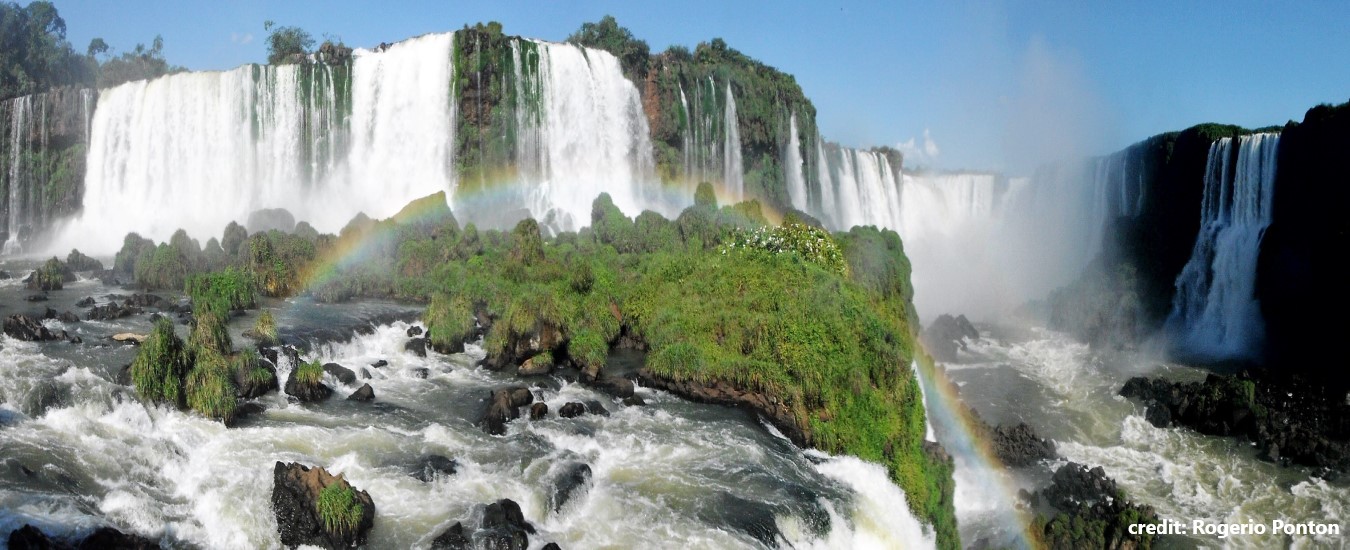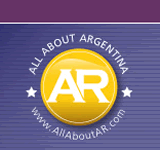
North America
& Caribbean |

South America
|

Africa
|
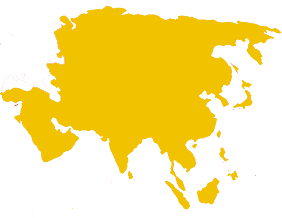
Asia
|
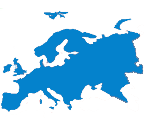
Europe
|

Australia &
Oceania |

Country Rankings
|

Beyond
Earth |
|
mail
ContactUs
|
|
info
AboutUs
|
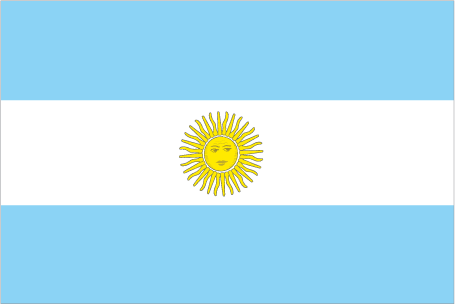
Flag
National anthem

Coat of arms
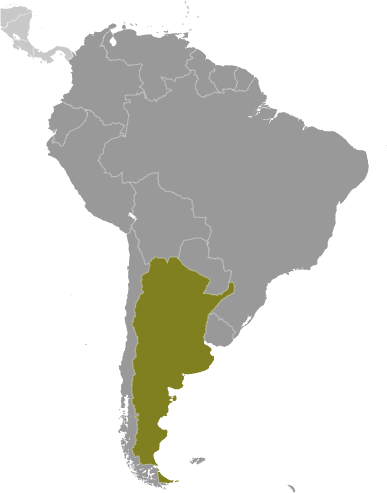
Country location map
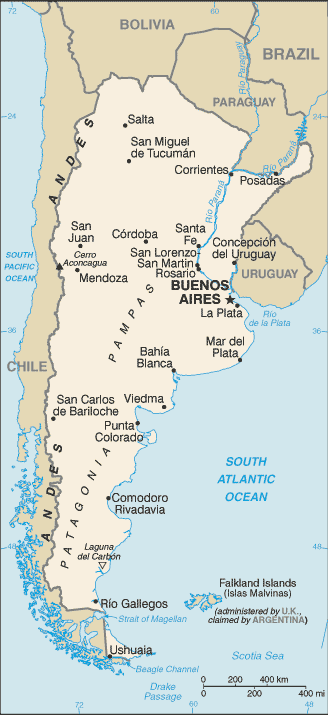
Country static map
Country dynamic (scrollable) map
Current weather & time
-
infoGeneral informationkeyboard_arrow_up
- Country common name: Argentina
- Country official name: Republica Argentina
- Continent: South America
- 3-Letter abbreviation: ARG
- 2-Letter abbreviation: AR
- Capital: Buenos Aires
- Major cities: 15.154 million BUENOS AIRES (capital), 1.573 million Cordoba, 1.532 million Rosario, 1.173 million Mendoza, 986,000 San Miguel de Tucuman, 884,000 La Plata
- Currency: Argentine peso (click for current conversion rates)
- Languages: Spanish (official), Italian, English, German, French, indigenous (Mapudungun, Quechua)
- Motto: "In Union and Freedom"
- National holiday(s): Revolution Day (May Revolution Day), 25 May (1810)
flagGovernmentkeyboard_arrow_up- Chief of state: President Javier Gerardo MILEI (since 10 December 2023); Vice President Victoria Eugenia VILLARRUEL (since 10 December 2023); note - the president is both chief of state and head of government
- Head of government: President Javier Gerardo MILEI (since 10 December 2023); Vice President Victoria Eugenia VILLARRUEL (since 10 December 2023)
- Government type: presidential republic
insert_photoCountry notes & photographskeyboard_arrow_up{"ops":[{"attributes":{"bold":true},"insert":"Argentina"},{"insert":" (Spanish pronunciation:("},{"attributes":{"height":"11","width":"11","link":"https://en.wikipedia.org/wiki/File:Es_Argentina.ogg"},"insert":{"image":"https://upload.wikimedia.org/wikipedia/commons/thumb/8/8a/Loudspeaker.svg/11px-Loudspeaker.svg.png"}},{"attributes":{"link":"https://upload.wikimedia.org/wikipedia/commons/0/0d/Es_Argentina.ogg"},"insert":"listen"},{"insert":")), officially the "},{"attributes":{"bold":true},"insert":"Argentine Republic"},{"insert":" (Spanish: "},{"attributes":{"italic":true},"insert":"Republica Argentina"},{"insert":"), is a country in the southern half of South America. Argentina covers an area of 2,780,400 km2 (1,073,500 sq mi), making it the "},{"attributes":{"bold":true},"insert":"second-largest country"},{"insert":" in South America after Brazil, the fourth-largest country in the Americas, and the eighth-largest country in the world. It shares the bulk of the Southern Cone with Chile to the west, and is also bordered by Bolivia and Paraguay to the north, Brazil to the northeast, Uruguay and the South Atlantic Ocean to the east, and the Drake Passage to the south. Argentina is a "},{"attributes":{"bold":true},"insert":"federal state"},{"insert":" subdivided into "},{"attributes":{"bold":true},"insert":"twenty-three provinces"},{"insert":", and one autonomous city, which is the federal capital and largest city of the nation, "},{"attributes":{"bold":true},"insert":"Buenos Aires"},{"insert":". The provinces and the capital have their own constitutions, but exist under a federal system. Argentina claims sovereignty over the "},{"attributes":{"bold":true},"insert":"Falkland Islands"},{"insert":", "},{"attributes":{"bold":true},"insert":"South Georgia"},{"insert":" and the "},{"attributes":{"bold":true},"insert":"South Sandwich Islands"},{"insert":", and a part of Antarctica.\nThe earliest recorded human presence in modern-day Argentina dates back to the Paleolithic period. The Inca Empire expanded to the northwest of the country in Pre-Columbian times. The country has its roots in Spanish colonization of the region during the 16th century. Argentina rose as the successor state of the Viceroyalty of the Rio de la Plata, a Spanish overseas viceroyalty founded in 1776. The declaration and fight for independence (1810-1818) was followed by an extended civil war that lasted until 1861, culminating in the country's reorganization as a federation. The country thereafter enjoyed relative peace and stability, with several waves of European immigration, mainly Italians and Spaniards, radically reshaping its cultural and demographic outlook; over 60% of the population has full or partial "},{"attributes":{"bold":true},"insert":"Italian ancestry"},{"insert":", and Argentine culture has significant connections to Italian culture.\n\nThe almost-unparalleled increase in prosperity led to Argentina becoming the seventh-wealthiest nation in the world by the early 20th century. In 1896, Argentina's GDP per capita surpassed that of the United States and was consistently in the top ten before at least 1920. Currently, it is ranked 62nd in the world. Following the Great Depression in the 1930s, Argentina descended into political instability and economic decline that pushed it back into underdevelopment, although it remained among the fifteen richest countries for several decades. Following the death of "},{"attributes":{"bold":true},"insert":"President Juan Peron "},{"insert":"in "},{"attributes":{"bold":true},"insert":"1974"},{"insert":", his widow and vice president,"},{"attributes":{"bold":true},"insert":" Isabel Peron"},{"insert":", ascended to the presidency, before being overthrown in "},{"attributes":{"bold":true},"insert":"1976"},{"insert":". The following military junta, which was supported by the United States, persecuted and murdered thousands of political critics, activists, and leftists in the Dirty War, a period of state terrorism and civil unrest that lasted until the election of Raúl AlfonsÃn as president in 1983.\n\nArgentina is a regional power, and retains its historic status as a middle power in international affairs. A major non-NATO ally of the United States, Argentina is a developing country that ranks 46th in the Human Development Index, the second-highest in Latin America after Chile. It maintains the "},{"attributes":{"bold":true},"insert":"second-largest economy in South America"},{"insert":", and is a member of "},{"attributes":{"italic":true},"insert":"G-15"},{"insert":" and "},{"attributes":{"italic":true},"insert":"G20"},{"insert":". Argentina is also a founding member of the "},{"attributes":{"italic":true},"insert":"United Nations"},{"insert":", "},{"attributes":{"italic":true},"insert":"World Bank"},{"insert":", "},{"attributes":{"italic":true},"insert":"World Trade Organization"},{"insert":", "},{"attributes":{"italic":true},"insert":"Mercosur, Community of Latin American and Caribbean States"},{"insert":" and the "},{"attributes":{"italic":true},"insert":"Organization of Ibero-American States"},{"insert":".\n"}]}terrainGeographic informationkeyboard_arrow_up- Surface area (in km²): 2,780,400
- Highest point: Cerro Aconcagua (located in the northwestern corner of the province of Mendoza; highest point in South America) 6,962 m
- Neighboring countries: Bolivia 942 km, Brazil 1263 km, Chile 6691 km, Paraguay 2531 km, Uruguay 541 km
- Neighboring seas and oceans: Atlantic Ocean
- Climate: mostly temperate; arid in southeast; subantarctic in southwest
radioRadio stationskeyboard_arrow_upsupervised_user_circlePopulationkeyboard_arrow_up- Population: 46,621,118
- Population density (inhabitants per km²): 16.8
- Average age (in years): 33.1
- Life expectancy at birth (in years): 77.8
- Ethnicity: European (mostly Spanish and Italian descent) and mestizo (mixed European and Amerindian ancestry) 97.2%, Amerindian 2.4%, African 0.4%
- Gross domestic product (GDP) per inhabitant (in US dollars): 21,500
- Cultural practices: Telephone Code54US Embassy/Consulate[54] (11) 5777-4533; US Embassy in Buenos Aires, Av. Colombia 4300,
local_diningPopular food & drinkskeyboard_arrow_up{"ops":[{"insert":"The way to Argentina's heart is through its "},{"attributes":{"bold":true},"insert":"asado"},{"insert":", simply meaning "},{"attributes":{"italic":true},"insert":"barbecue"},{"insert":", also known as "},{"attributes":{"bold":true},"insert":"parrillada"},{"insert":". Don't leave the country without spending a leisurely afternoon beside the warmth of a grill or open fire, feasting on copious grilled meats. This is the "},{"attributes":{"bold":true},"insert":"national dish"},{"insert":", originating from the country's "},{"attributes":{"bold":true},"insert":"gauchos"},{"insert":", or cowboys, who would subsist on the abundant cows dotting the country's plains. This is one of the five countries in the world with more cattle than people, so "},{"attributes":{"bold":true},"insert":"steak "},{"insert":"is rather prevalent. In addition, expect to find "},{"attributes":{"italic":true},"insert":"pork"},{"insert":", "},{"attributes":{"italic":true},"insert":"ribs"},{"insert":", "},{"attributes":{"italic":true},"insert":"sausages"},{"insert":", "},{"attributes":{"italic":true},"insert":"blood sausages"},{"insert":" and "},{"attributes":{"italic":true},"insert":"sweetbreads"},{"insert":" hot off the fire. In Patagonia, look out for a "},{"attributes":{"italic":true},"insert":"whole lamb"},{"insert":" or "},{"attributes":{"italic":true},"insert":"pig "},{"insert":"roasting over an open flame. Lightly salted, topped with "},{"attributes":{"italic":true},"insert":"chimichurri"},{"insert":" and paired with "},{"attributes":{"italic":true},"insert":"malbec "},{"insert":"wine, well this is Argentina.\n"}]}
{"ops":[{"attributes":{"bold":true},"insert":"Chimichurri"},{"insert":" is an "},{"attributes":{"bold":true},"insert":"uncooked sauce"},{"insert":" used both as an "},{"attributes":{"bold":true},"insert":"ingredient "},{"insert":"in cooking and as a table "},{"attributes":{"bold":true},"insert":"condiment "},{"insert":"for grilled meat (see "},{"attributes":{"bold":true},"insert":"asado"},{"insert":", left). A type of green salsa made of finely chopped parsley, oregano, onion, garlic, chilli pepper flakes, olive oil and a touch of acid, such as lemon or vinegar, chimichurri is the country's go-to condiment. This tangy, garlicky salsa is sometimes used as a marinade, though most often it is found blanketing grilled meats and heaps of other savory foods throughout the country.\n"}]}
{"ops":[{"insert":"Argentinians give whole new meaning to "},{"attributes":{"bold":true},"insert":"grilled cheese"},{"insert":" with their trademark dish of "},{"attributes":{"bold":true},"insert":"provoleta"},{"insert":". A consequence of the significant Italian immigration to Argentina, provoleta is the country's "},{"attributes":{"italic":true,"bold":true},"insert":"variant on "},{"attributes":{"bold":true},"insert":"provolone"},{"insert":". Pungent, sharp, sliced discs of the cheese are topped with "},{"attributes":{"italic":true},"insert":"chilli flakes"},{"insert":" and "},{"attributes":{"italic":true},"insert":"herbs"},{"insert":", like "},{"attributes":{"italic":true},"insert":"oregano"},{"insert":", then grilled. The nearly melted cheese is served crisp and slightly "},{"attributes":{"bold":true},"insert":"caramelized "},{"insert":"on the outside, "},{"attributes":{"bold":true},"insert":"gooey "},{"insert":"and "},{"attributes":{"bold":true},"insert":"smokey "},{"insert":"on the interior. Top it off with a drizzle of olive oil or a spoonful of chimichurri.\n"}]}
{"ops":[{"attributes":{"bold":true},"insert":"Malbec"},{"insert":" is Argentina's "},{"attributes":{"bold":true},"insert":"blockbuster wine"},{"insert":", in all its lush and fruity glory. Yes, you want that "},{"attributes":{"italic":true},"insert":"deep, dark color"},{"insert":" backed by "},{"attributes":{"italic":true},"insert":"bold aromas"},{"insert":" and husky flavors of "},{"attributes":{"italic":true},"insert":"black fruits"},{"insert":" and "},{"attributes":{"italic":true},"insert":"oak"},{"insert":"; and you want it with empanadas and a juicy steak off the grill. Originally a Bordeaux grape, Malbec now makes up about "},{"attributes":{"bold":true},"insert":"half of Argentina's wine exports"},{"insert":". From "},{"attributes":{"bold":true},"insert":"Mendoza"},{"insert":", the heart of Argentinian's wine country, up north to San Juan and Salta, the grape reflects the many "},{"attributes":{"italic":true},"insert":"terroirs"},{"insert":" (the combination of factors including soil, climate, and sunlight that gives wine grapes their distinctive character)"},{"attributes":{"bold":true},"insert":" "},{"insert":"from which it hails. When grown in warm regions to the north, Malbec is often "},{"attributes":{"italic":true},"insert":"dark, higher in alcohol"},{"insert":" and "},{"attributes":{"italic":true},"insert":"inflected with oak"},{"insert":". From the higher, cooler reaches of Mendoza, the wines tend to have "},{"attributes":{"italic":true},"insert":"greater natural acidity"},{"insert":".\n"}]}
local_post_officePostage stampskeyboard_arrow_up{"ops":[{"insert":"The "},{"attributes":{"bold":true},"insert":"first stamp"},{"insert":" of Argentina as a nation was a rather "},{"attributes":{"italic":true},"insert":"crude lithographed seal of the Confederation"},{"insert":" in "},{"attributes":{"bold":true},"insert":"1858"},{"insert":", followed in 1862 by the seal of the Argentine Republic. From 1864 to the first commemorative in 1892 a total of 24 different designs were issued. The majority of these stamp designs were small portraits of famous men, principally of the Independence period. The stamps do not identify these heroes of independence, so they would have meant little to anyone who was not familiar with Argentine history.\n"}]}
{"ops":[{"insert":"The "},{"attributes":{"bold":true},"insert":"1986 World Football (Soccer) Cup"},{"insert":" was "},{"attributes":{"bold":true},"insert":"won by Argentina"},{"insert":" (their second title, after winning in 1978). The above stamp commemorates this major sports achievement. Argentina was captained by the 25-year-old "},{"attributes":{"bold":true},"insert":"Diego Maradona"},{"insert":", who played a large part in his team's success by scoring his "},{"attributes":{"italic":true},"insert":"\"Hand of God\""},{"insert":" goal, as well as another voted "},{"attributes":{"italic":true},"insert":"\"Goal of the Century\""},{"insert":", in the same quarter-final against England. These were two of the five goals that Maradona scored during the tournament, and he also assisted in another five for his teammates. Argentina beat West Germany 3–2 in the final at Mexico City's Estadio Azteca. Total attendance was 2,394,031, an average per match of 46,039. Canada, Denmark and Iraq made their first appearances at the final stage\n"}]}
{"ops":[{"insert":"In "},{"attributes":{"bold":true},"insert":"2020"},{"insert":" the Argentine Postal Service issued a commemorative stamp marking the "},{"attributes":{"bold":true},"insert":"250th Anniversary of the birth of Ludwig van Beethoven"},{"insert":" (1770-1827). "},{"attributes":{"bold":true},"insert":"Beethoven "},{"insert":"was a "},{"attributes":{"bold":true},"insert":"German composer"},{"insert":" and "},{"attributes":{"bold":true},"insert":"pianist"},{"insert":". Beethoven remains one of the most admired composers in the history of Western music; his works rank amongst the most performed of the classical music repertoire and span the transition from the "},{"attributes":{"bold":true},"insert":"Classical period"},{"insert":" to the "},{"attributes":{"bold":true},"insert":"Romantic era"},{"insert":" in classical music. His career has conventionally been divided into early, middle, and late periods. His early period, during which he forged his craft, is typically considered to have lasted until 1802. From 1802 to around 1812, his middle period showed an individual development from the styles of Joseph Haydn and Wolfgang Amadeus Mozart, and is sometimes characterized as heroic. During this time, he began to grow increasingly deaf. In his late period, from 1812 to 1827, he extended his innovations in musical form and expression.\n"}]}
{"ops":[{"insert":"This "},{"attributes":{"bold":true},"insert":"2021 "},{"insert":"commemorative stamp celebrates "},{"attributes":{"bold":true},"insert":"Ernesto Saqbato"},{"insert":", in full "},{"attributes":{"bold":true},"insert":"Ernesto Roque Sabato"},{"insert":", (born June 24, 1911, Rojas, Argentina, died April 30, 2011, Buenos Aires), He was a famous Argentine novelist, journalist, and essayist whose novels are notable for their concern with philosophical and psychological issues and whose political and social studies were highly influential in Argentina in the latter half of the 20th century.\n"}]}
tap_and_playTelephone & Internet communicationkeyboard_arrow_up- Country international telephone code: +54
- Local emergency telephone number(s): Ambulance: 101; Fire: 107; Police: 101
- Internet code: .ar
- Number of Internet users: 39,186,889
- Percentage of Internet-connected population: 84.1%
gradeAlso useful to knowkeyboard_arrow_up- Vaccinations: An International Certificate of Vaccination for yellow fever is required for travelers arriving from countries with a risk of yellow fever transmission and for travelers having transited through the airport of a country with risk of yellow fever transmission. For recommendations please refer to the World Health Organization (WHO), or the U.S. Centers for Disease Control (CDC) websites.
- Potable/drinkable water: Opt for bottled water.
- International driving permit: Suggested; additionally, if you plan to drive in Argentina, you will need an
- Road driving side: Right
-
Electricity/Voltage/Plug type(s):
220 V / 50 Hz / plug type(s): C, I
keyboard_arrow_leftkeyboard_arrow_right10
-
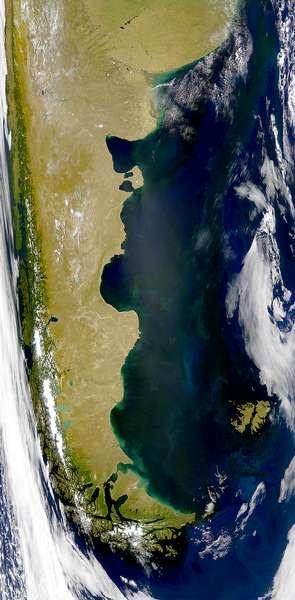
{"ops":[{"insert":"Summertime (January) satellite image of the "},{"attributes":{"bold":true},"insert":"southern cone of South America"},{"insert":" showing green vegetation on the "},{"attributes":{"bold":true},"insert":"Andes Mountains"},{"insert":" of south Chile, the "},{"attributes":{"bold":true},"insert":"Patagonian plain"},{"insert":"s of south Argentina, and the "},{"attributes":{"bold":true},"insert":"Falkland Islands"},{"insert":". The bright green areas are algal blooms. Photo courtesy of NASA.\n"}]}
-
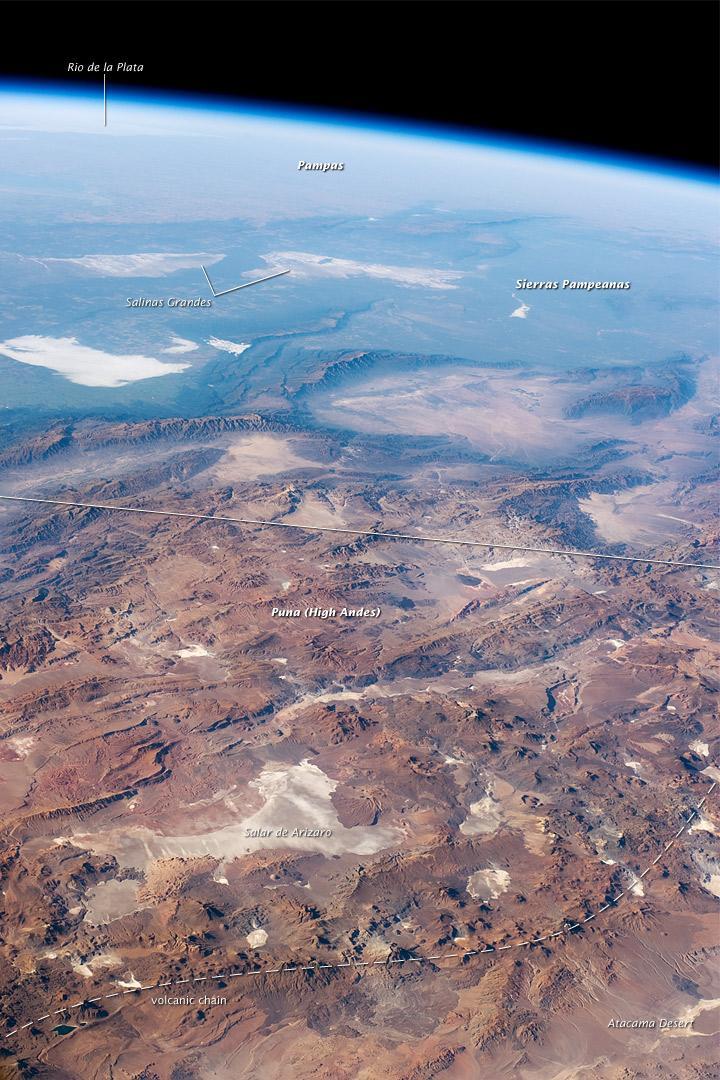
{"ops":[{"insert":"This panorama looking "},{"attributes":{"bold":true},"insert":"southeast"},{"insert":" across the "},{"attributes":{"bold":true},"insert":"South American continent"},{"insert":" was taken from the International Space Station almost directly over the "},{"attributes":{"bold":true},"insert":"Atacama Desert"},{"insert":" near Chile's Pacific coast. The high plains (3000-5000 m, 13,000-19,000 ft) of the "},{"attributes":{"bold":true},"insert":"Andes Mountains"},{"insert":", also known as the "},{"attributes":{"bold":true},"insert":"Puna"},{"insert":", appear in the foreground, with a line of young volcanoes (dashed line) facing the much lower Atacama Desert (1000-2000 m elevation). Several salt-crusted dry lakes (known as "},{"attributes":{"bold":true},"insert":"salars"},{"insert":" in Spanish) occupy the basins between major thrust faults in the Puna. Salar de Arizaro (foreground) is the largest of the dry lakes in this view. The Atlantic Ocean coastline, where Argentina's capital city of "},{"attributes":{"bold":true},"insert":"Buenos Aires"},{"insert":" sits along the Rio de la Plata, is dimly visible at image top left. Near image center, the transition (solid line) between two distinct geological zones, the Puna and the Sierras Pampeanas, creates a striking landscape contrast. Compared to the Puna, the Sierras Pampeanas mountains are lower in elevation and have fewer young volcanoes. Sharp-crested ridges are separated by wide, low valleys in this region. The "},{"attributes":{"bold":true},"insert":"Salinas Grandes"},{"insert":" - ephemeral shallow salt lakes - occupies one of these valleys. The general color change from "},{"attributes":{"bold":true},"insert":"reds"},{"insert":" and "},{"attributes":{"bold":true},"insert":"browns "},{"insert":"in the foreground to "},{"attributes":{"bold":true},"insert":"blues "},{"insert":"and "},{"attributes":{"bold":true},"insert":"greens "},{"insert":"in the upper part of the image reflects the major climatic regions: the deserts of the Atacama and Puna versus the grassy plains of central Argentina, where rainfall is sufficient to promote lush prairie grass, known locally as the "},{"attributes":{"bold":true},"insert":"pampas"},{"insert":". The Salinas Grandes mark an intermediate, semiarid region. Image courtesy of NASA.\n"}]}
-
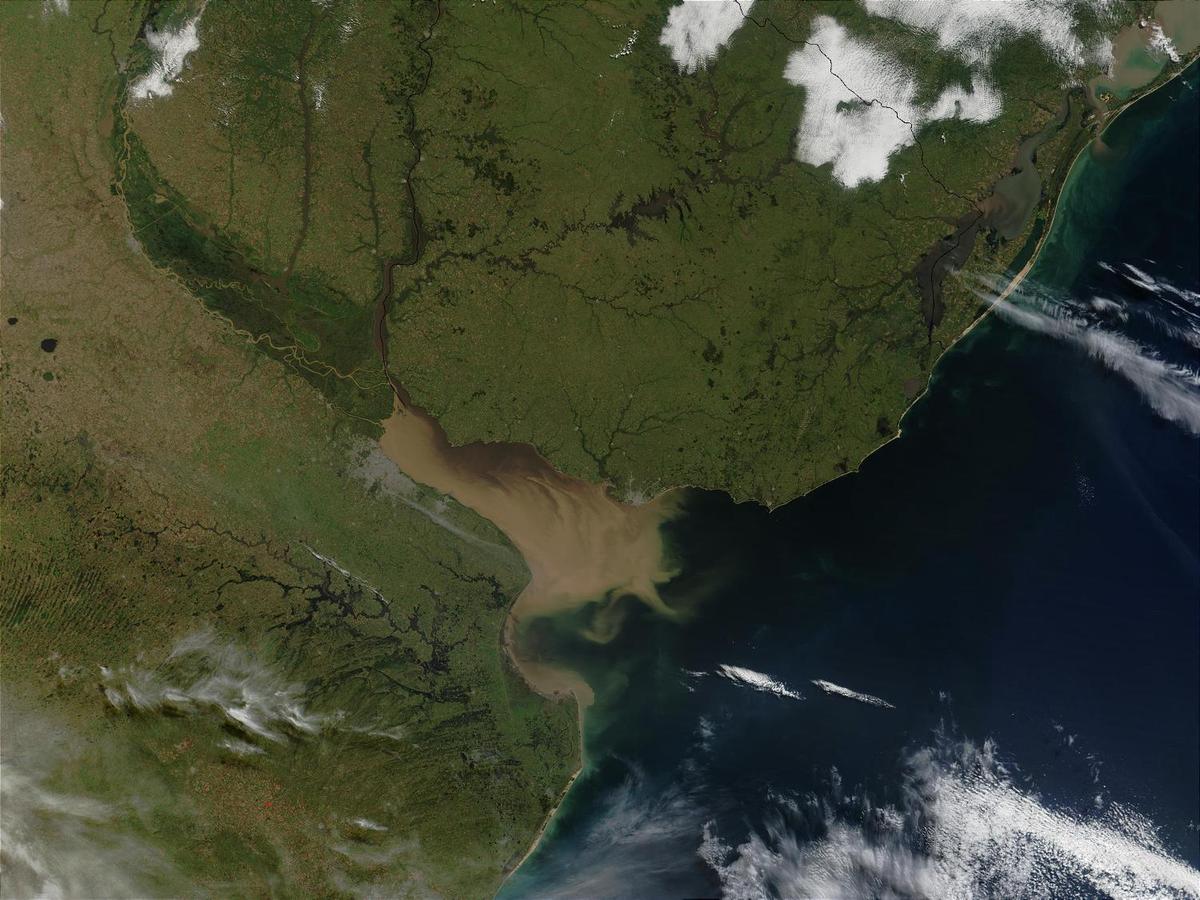
The Rio Parana in Argentina (running north-south through image center) appears brown from its sediment; it eventually drains into the Delta del Parana and the Rio de la Plata estuary. Where the Rio de la Plata empties into the Atlantic, the brown, sediment-filled river water mixes with clearer ocean water and creates swirls and cloudy formations. Visible in this image (in gray) is Buenos Aires, the capital city of Argentina, located where the Rio Parana meets the Rio de la Plata. Montevideo, Uruguay's capital, is located on the opposite side of the Rio de la Plata. Photo courtesy of NASA.
-
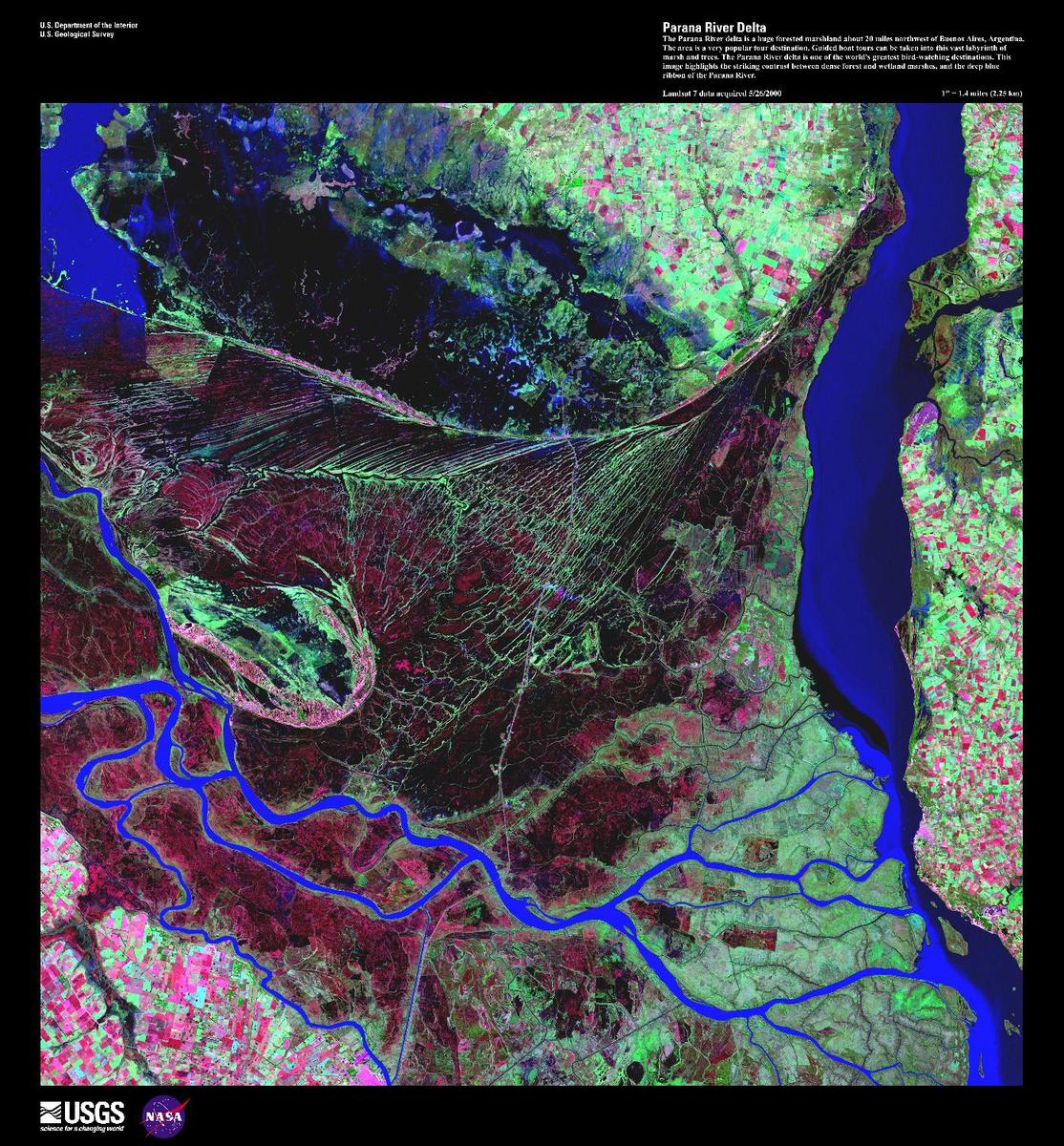
The Parana is the second longest river is South America; its delta is a huge forested marshland about 32 km (20 mi) northeast of Buenos Aires. The area is a very popular tourist destination with guided boat tours that venture into this vast labyrinth of marsh and trees. The Parana River delta is one of the world's greatest bird-watching destinations. This false color satellite image highlights the striking contrast between dense forest and wetland marshes (deep red and violet), and the winding blue ribbon of the Parana River. The large north-south-trending water body on the right is the Uruguay River. Image courtesy of USGS.
-
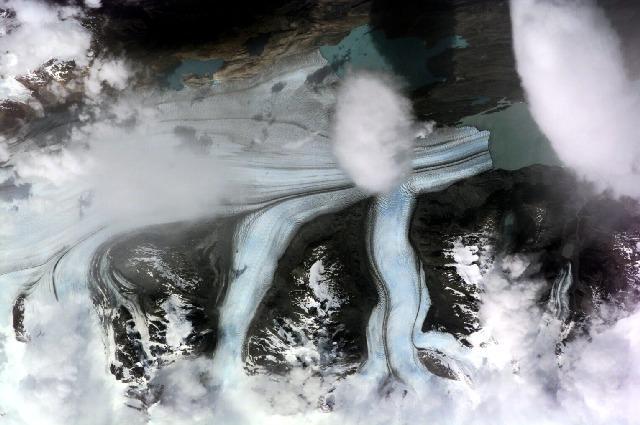
The Upsala Glacier in Argentina - here viewed from the International Space Station - is the third largest glacier of the Southern Patagonian Ice Field with an estimated area of over 800 sq km. This long, north-south oriented river of ice terminates in the northern arm of Lake Argentino. Photo courtesy of NASA.
-
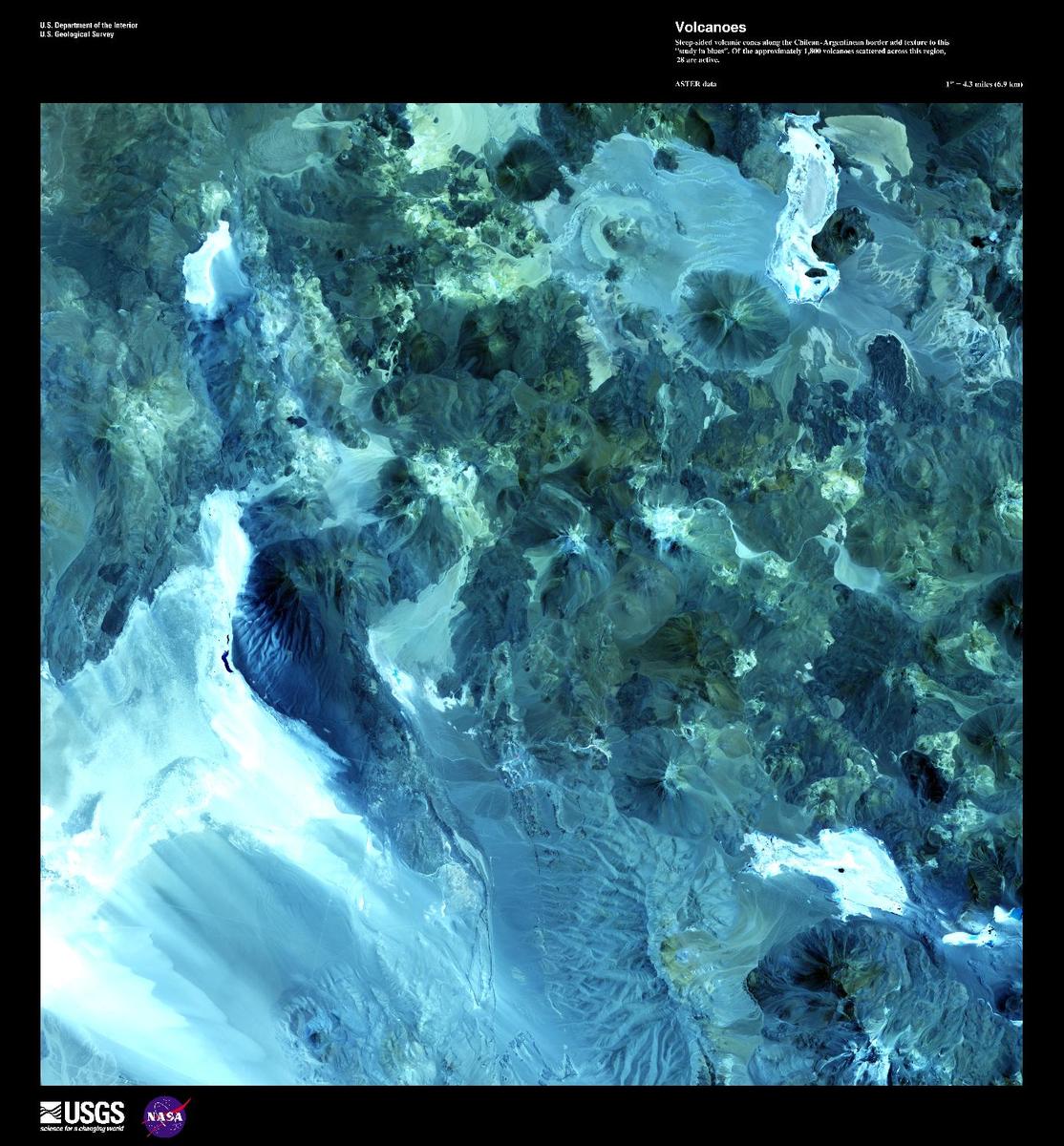
Steep-sided volcanic cones along the Andes on the Chilean-Argentinean border add texture to this false-color satellite image. Of approximately 1,800 volcanoes scattered across this region, 28 are active and form part of the Andean volcanic belt that runs down the length of South America. For more information on other active volcanoes in the region, see the Natural hazards - volcanism subfield in the Geography section under either Chile or Argentina. Image courtesy of USGS.
-
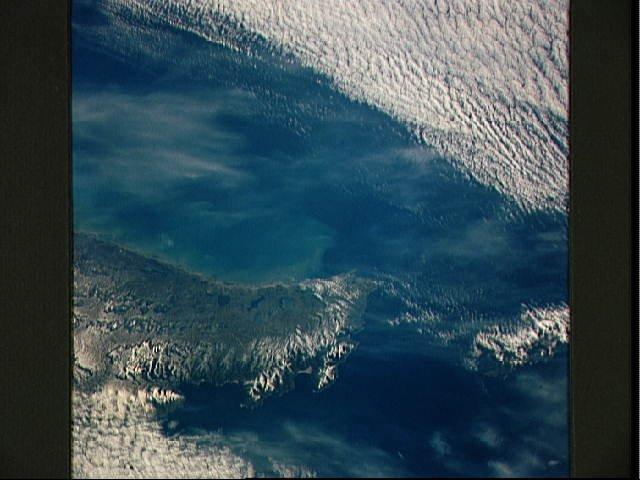
The Mitre Peninsula is the easternmost tip of Tierra del Fuego, Argentina. Early winter snow may be seen on this south tip of the Andes Mountains. These same mountains continue underwater to Antarctica. The Strait of Magellan, separating the South American mainland from Tierra del Fuego, is off the scene to the north and west, but the Strait of Le Maire, separating Tierra del Fuego from the Isla de los Estados may be seen off to the east (right). Image courtesy of NASA.
-
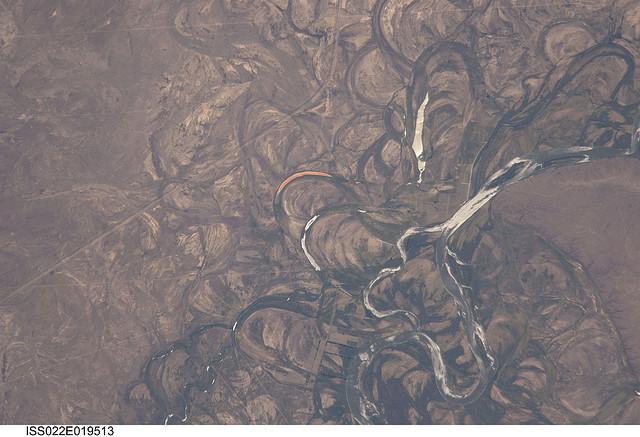
The Rio Negro in Patagonia is recognizable from space as one of the most meandering rivers in South America. This phenomenon is well illustrated in this view, where the entire river floodplain (approximately 10 km (6 mi) wide) is covered with curved relics of channels known as meander scars. The main channel of the river, flowing south at this point 60 km (36 mi) south of the city of Choele Choel (not shown) appears in partial sun glint at right. Sun glint occurs when light is reflected off a water surface directly back towards the viewer, imparting a silvery sheen to those areas. When meander scars contain water they are known as oxbow lakes, some of which are also highlighted by sun glint in the image. Meander scars show the numerous past positions of river bends, produced as the river snaked across the plain in the very recent geological past. The Rio Negro is a dramatic example of how mobile a river can be. The orange tint to the water in one of the oxbow lakes (center) could result from orange salt-loving algae. Image courtesy of NASA.
-

Buenos Aires at night. The brightness of the lights reflects the density of the urban population, which declines to blackness in the farmlands that surround the city. The brightest area is the old part of the city centered on the port and the presidential palace. The blackest part of the scene is the River Plate, the great estuary of the Atlantic Ocean on which this port city is located. The widest city thoroughfare in the world - the Avenida 9 de Julio - is the brightest line in the downtown cluster. It appears as the longest north-south strip just inland of the port. Image courtesy of NASA.
-
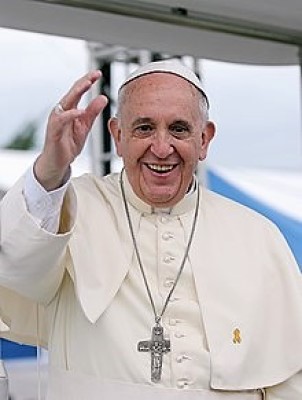
{"ops":[{"attributes":{"bold":true},"insert":"Pope Francis "},{"insert":"(Latin: "},{"attributes":{"bold":true},"insert":"Franciscus"},{"insert":"; Italian: "},{"attributes":{"bold":true},"insert":"Francesco"},{"insert":"; Spanish: "},{"attributes":{"bold":true},"insert":"Francisco"},{"insert":"; born Jorge Mario Bergoglio, 17 December "},{"attributes":{"bold":true},"insert":"1936 "},{"insert":"in"},{"attributes":{"bold":true},"insert":" Argentina"},{"insert":") is the "},{"attributes":{"bold":true},"insert":"head of the Catholic Church"},{"insert":". He has been sovereign of the Vatican City State since 13 March 2013. Francis is the first pope to be a member of the Society of Jesus, the first from the Americas, the first from the Southern Hemisphere, and the first pope from outside Europe since Gregory III, a Syrian who reigned in the 8th century. \n"}]}
-
A rainbow appears in the mist of Iguazu Falls. The falls are part of a nearly virgin jungle ecosystem surrounded by national parks on both the Argentine and the Brazilian sides of the cascades. The Iguazu River begins in Parana state of Brazil, then crosses a 1,200-km (750 mi) plateau before reaching a series of faults forming the falls.
-
A bird's eye view of Iguazu Falls on the Argentine-Brazil border.
-

Argentina won the 2022 FIFA World Cup in Qatar. It was the third world title for the Argentinian national team after the 1978 and 1986 wins.
-

{"ops":[{"attributes":{"bold":true},"insert":"Lionel Andrés Messi"},{"insert":" (Spanish pronunciation: [ljoˈnel anˈdɾes ˈmesi]("},{"attributes":{"link":"https://upload.wikimedia.org/wikipedia/commons/0/09/Lionel_Andr%C3%A9s_Messi_-_Name.ogg"},"insert":"listen"},{"insert":"); born 24 June 1987), also known as "},{"attributes":{"bold":true},"insert":"Leo Messi"},{"insert":", is an Argentine professional footballer who plays as a forward for Ligue 1 club Paris Saint-Germain and captains the Argentina national team. Widely regarded as one of the greatest players of all time, in December 2002 he captained the Argentina national team to win the FIFA World Cup, held in Qatar.\n"}]}
keyboard_arrow_up

